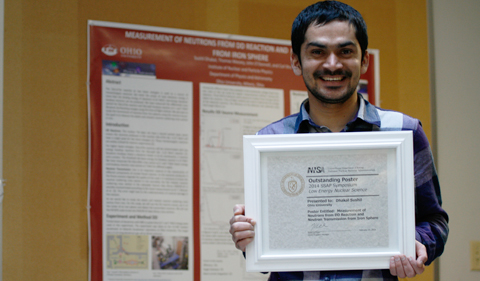Dr. Carl Brune, Professor of Physics, has received a Lawrence Livermore National Laboratory Director’s Science and Technology Award for excellence in a basic science publication.
Brune was selected for his contributions as a member of the team that published “Measurement of the T + T Neutron Spectrum Using the National Ignition Facility” in Physical Review Letters.
The Director’s Science and Technology Awards were initiated in 2000 to acknowledge and celebrate especially significant accomplishments by the laboratory’s scientific, technical, and engineering staff. The awards are presented annually to LLNL individuals and teams who have made outstanding recent contributions that are widely acknowledged both internally and outside the laboratory.
The lead author on the paper is Ohio University alum Dr. Dan Sayre, who studied with Brune and earned a Ph.D. in Physics in 2011. He took a postdoc position at Lawrence Livermore National Laboratory and was recently promoted to a term staff position there.
Brune was involved in the development of the neutron detectors at the National Ignition Facility. “This was something that grew out of my Fall 2009 sabbatical that I spent at LLNL (and also the nearby Lawrence Berkeley National Lab),” he said. “My main contribution was the physical interpretation of the data, particularly the calculations of the curves in the figures.”
Abstract: Neutron time-of-flight spectra from inertial confinement fusion experiments with tritium-filled targets have been measured at the National Ignition Facility. These spectra represent a significant improvement in energy resolution and statistics over previous measurements, and afford the first definitive observation of a peak resulting from sequential decay through the ground state of 5He at low reaction energies Ec.m.≲100 keV. To describe the spectrum, we have developed an R-matrix model that accounts for interferences from fermion symmetry and intermediate states, and show these effects to be non-negligible. We also find the spectrum can be described by sequential decay through ℓ=1 states in 5He , which differs from previous interpretations.




















Comments